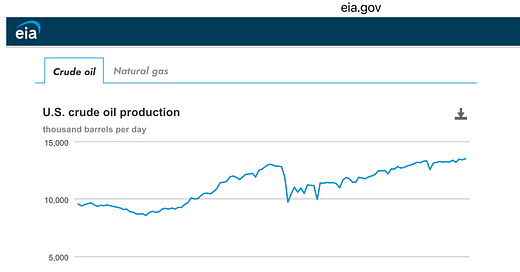Oil and Gas Prices: A Rough Few Weeks, but the Fundamentals Will Matter
It’s been a rough couple of weeks in oil and gas. Why? A combination of factors—OPEC’s quiet maneuvering to reduce surplus capacity, persistent recession fears now that the market has awoken to the true state of affairs in the U.S. economy, and the looming possibility of Russian oil sanctions being lifted in the event of the end of conflict in Ukraine. On the natural gas side, the U.S. continues to sit on an abundance of supply with limited pipelines and LNG export terminals to move it to premium markets. And as always, the EIA 914 report is instructive. It shows capped natural gas—trapped by infrastructure constraints—and U.S. oil production that has likely peaked (I know, I know… I’ve been saying it since September 2019 but we were 13 mmbo/d then, 13.49 mmbo/d in December 2024 and that was only 175 mbo/d above December 2023…)
The Breakeven Price of a Commodity Matters
Unless you make polysilica for solar panels in China, break-even prices define market cycles. The idea that U.S. shale can ramp up production at any price is outdated. As of 2024, the average full-cycle break-even price for U.S. shale sits around $54 per barrel, with major basins like the Delaware requiring $56+ per barrel and the Midland and Eagle Ford closer to $66+ per barrel. These are the public numbers, managed by IR, and optimistic engineers. The bigger limit is the amount of inventory available at that break even price, and it’s shrinking monthly.
On the gas side, historical numbers suggest profitability at around $3 per MMBtu, yet in 2024, prices have hovered near $2.65 per MMBtu—a gas rebound is always around the corner, and has been since 2012, but the truth is at natural gas prices over 2024, operators are feeling the squeeze.
I think that industry has learned its lesson from COVID (and subscribing to hottakeoftheday back in those days). Rather than drill aggressively into weak pricing, expect a quiet ramp down of completions, a rebuilding of DUC (drilled but uncompleted) well inventory, and an emphasis on reducing debt rather than chasing marginal barrels. With many E&P stock prices down 25-50%, M&A and consolidation will have to wait: no management team is heading for the exit at this prices.
Declines Are a Given, and Even a Modest Slowdown Has an Impact
The nature of shale means that even six months of reduced activity could pull as much as 1.3 million barrels per day off the market. And that doesn’t count the impact of Canadian tariffs. Natural gas has enough economic production to backfill lost volumes, but oil doesn’t have the same luxury. OPEC’s so-called spare capacity remains unknown and unverified, the underlying supply picture looks much tighter by 2026.
Natural Gas: A Long-Term Bullish Case
The manufacturing renaissance in America—driven by onshoring, AI’s power demands, and the continued decline of wind power—puts upward pressure on long-term natural gas demand. The infrastructure gap remains the bottleneck. New LNG terminals and expanded pipeline capacity are the only real solutions to closing the arbitrage with European and Asian markets. Until then, supply keeps prices low domestically, frustrating producers but reinforcing the inevitable need for higher gas prices over time.
Can Oil Go Lower? Absolutely. But Not for Long.
Sure, oil can still go lower, but short of another global collapse, $50-$55 per barrel is where real pain starts for U.S. producers. At $65, no one is happy. Expect to see capital redeployment, a sharp pullback in drilling, and eventually a hard snapback when the market realizes just how much supply has quietly been removed.
Pick your favorite name and get ready for the ride. The cycle isn’t dead. It’s just playing out slower, and smarter operators are already adjusting.




